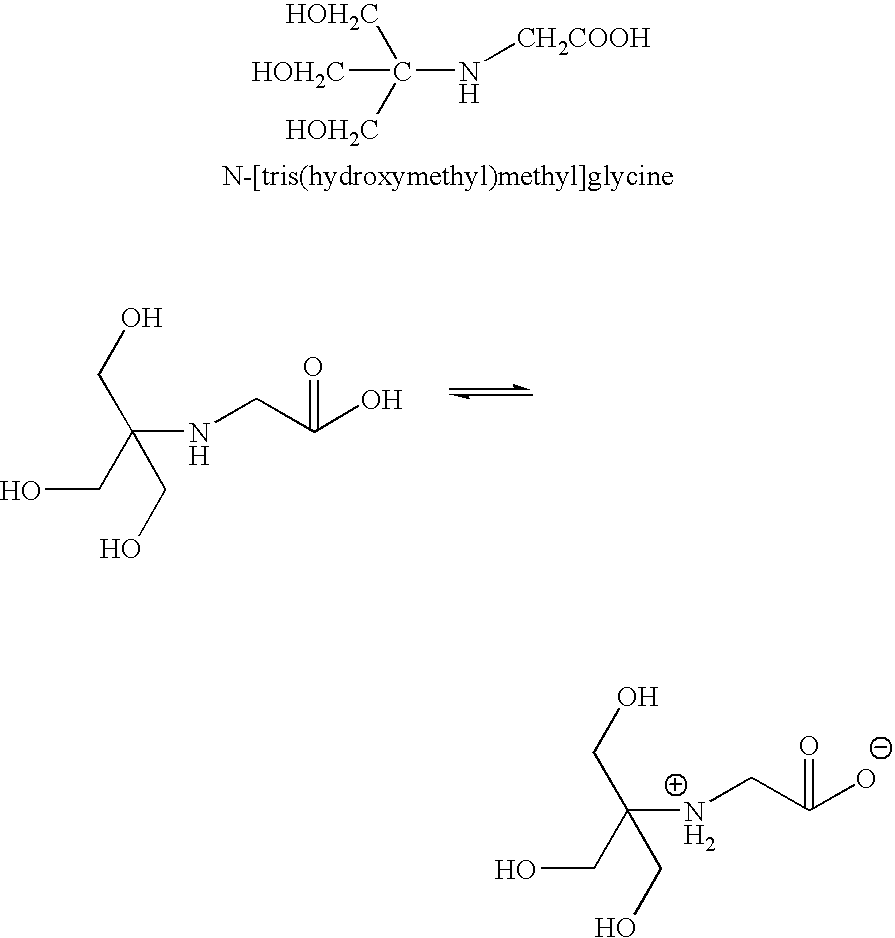Use of organic buffering agents to enhance the antimicrobial activity of pharmaceutical compositions
a technology of organic buffering agents and antimicrobial activity, which is applied in the direction of antibacterial agents, detergent compounding agents, peptide/protein ingredients, etc., can solve the problems of compromising the sterility of the product, reducing the antimicrobial activity and potential toxicological activity of anti-microbial agents, and affecting the antimicrobial activity of the composition. , to achieve the effect of enhancing the antimicrobial activity of the composition, reducing the amount of anti-microbial
- Summary
- Abstract
- Description
- Claims
- Application Information
AI Technical Summary
Benefits of technology
Problems solved by technology
Method used
Image
Examples
example 1
[0042] Three pairs of contact lens disinfecting solutions were prepared for evaluation. Each pair consisted of a first solution that contained an organic buffer in accordance with the present invention (i.e., tricine), and a second solution that was identical to the first solution, except for the absence of the organic buffer. The compositions of the solutions are shown in Table 1, below:
TABLE 1Formulation Numbers / Concentrations (% w / v)A1A2B1B2C1C2Component(9319-3A)(9319-3B)(9198-43A)(9198-43B)(9319-41A)(9319-41B)AL 84960.00010.0001——0.00030.0003Polyquaternium-1——0.00110.0011——Sorbitol————0.40.4Na Borate————0.20.2Na citrate dihydrate————0.60.6Boric Acid0.60.60.60.6——Sodium Chloride0.320.320.320.32——Propylene Glycol0.50.59.50.51.01.0Tricine—0.2—0.2—0.2Poloxamine 13040.050.050.050.050.10.1Purified waterq.s.q.s.q.s.q.s.q.s.q.s.HCl / NaOHAdj.Adj.Adj.Adj.Adj.Adj.Osmolality——————PH7.87.87.07.07.87.8
[0043] The solutions were prepared as follows: 250 mL beakers were filled with purified wat...
example 2
[0053] Table 3 (below) shows three pairs of formulations that were evaluated relative to the effect of tricine on antimicrobial activity levels. Each pair consisted of a first solution containing 1 ppm of the amino biguanide AL-8496 and 2 ppm of the polymeric quaternary ammonium agent polyquaternium-1, and a second solution that was identical to the first solution, except for the inclusion of tricine at a concentration of 0.2% w / v. The formulations were prepared and evaluated via the procedures described in Example 1. The results are presented in Table 3, below:
TABLE 3Formulation Numbers / Concentrations (% w / v)A1A2B1B2C1C2Component10363-11A10363-11B10363-11E10363-11F10363-11G10363-11HPolyquaternium-10.00020.00020.00020.00020.00020.0002AL-8496A*0.00010.00010.00010.00010.00010.0001Sodium borate0.60.60.60.60.60.6Poloxamine 13040.050.050.050.050.050.05Sodium chloride0.30.3————Propylene glycol——1.01.01.01.0EDTA0.050.050.050.050.050.05Sorbitol0.40.40.40.40.80.8Tricine—0.2—0.2—0.2pH7.87.8...
PUM
| Property | Measurement | Unit |
|---|---|---|
| Antimicrobial properties | aaaaa | aaaaa |
Abstract
Description
Claims
Application Information
 Login to View More
Login to View More - R&D
- Intellectual Property
- Life Sciences
- Materials
- Tech Scout
- Unparalleled Data Quality
- Higher Quality Content
- 60% Fewer Hallucinations
Browse by: Latest US Patents, China's latest patents, Technical Efficacy Thesaurus, Application Domain, Technology Topic, Popular Technical Reports.
© 2025 PatSnap. All rights reserved.Legal|Privacy policy|Modern Slavery Act Transparency Statement|Sitemap|About US| Contact US: help@patsnap.com


